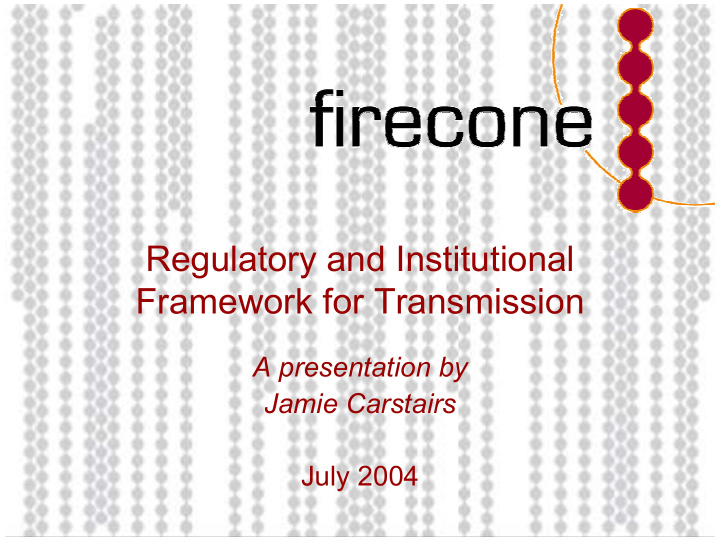



Regulatory and Institutional Framework for Transmission A presentation by Jamie Carstairs July 2004
Agenda Agenda • Scope of Work • Regulation and Markets • Regional Structure • Reliability and Service Standards • Planning and Investment • Financial Markets • Implications 2
Scope of work Scope of work • To assist Ministers to determine the appropriate way forward for transmission regulation, and • To provide specific recommendations, based on qualitative analysis, on institutional and regulatory changes to: Purpose of review – improve the investment climate – lower the cost and complexity of regulation – improve the planning and development of transmission networks Recommendations were required to support the original intent of the NEM: an effective transmission system, supporting competition relying overwhelmingly on regulated investments 3
Regulation and markets Regulation and markets Future directions Simplified regulation Investment against based on price price differentials differentials Continued interaction “Two merchant lines supported by “Assessments relating to new of markets and differences in spot prices in the regulated transmission investments regulation two market areas they connect need to be rationalised, with have been placed in operation regulatory assessment linked to Firecone recommendations: under this arrangement [that is, measurable and transparent MNSP provisions] in commercial benefits, as signalled • Two broadly separate approaches: Australia…..Neither merchant link through movements in firm FTR regulated networks and wholesale appears to be profitable. As far as prices …..Additional regions will and retail markets; we can tell, these are the only two allow the FTRs to provide a market merchant transmission lines signal for the need for augmentation, • Firm and inevitably somewhat operating anywhere in the world rather than relying on regulatory arbitrary separation; that have been built in anticipation discretion” Energy Markets Review, 2002 of recovering their costs entirely • Regulated sector should provide a from congestion rents arising from transparent predictable base against the difference in nodal prices” which market participants can Joskow and Tirole, 2003 respond 4
Regional Structure Regional Structure Findings • The Code criteria have been met but change has stalled • Firecone recommended a change to the criteria to make them more economic and less technical • Possible criteria included: Recommendation – transparent and effective processes for maintenance of power system security – static, dynamic and allocative efficiency – ability to manage and price risks Outcome • A study is being undertaken by CRA/NECG to determine the criteria 5
Reliability and service standards Reliability and service standards • Effective regulation requires clear and appropriate reliability and service standards; however: – Code reliability requirements are open to interpretation Findings – State-based instruments use widely differing forms of planning criteria, and their underlying rationale is not always clear – Service incentives that had been proposed by NEMMCO were technically focussed (hours of constraints) not market focussed (cost of constraints) • A working group (Reliability Panel + TNSP representatives) should make recommendations to AEMC on a transparent and consistent framework for setting appropriate and consistent reliability obligations Recommendation • Service standard incentives should move towards congestion costs and unserved energy attributable to transmission outage, with the level of incentive calibrated to TNSP controllable costs • ACCC has established working group to consider how to incorporate market based performance incentives within the service standard Outcome incentive scheme 6
Planning and investment Planning and investment • There may be reason for concern that TNSPs do not prioritise projects that primarily benefit other regions • Inefficient underinvestment may occur as a result of problems with Findings project identification, prioritisation and investment • Reliance on an e-post review of prudency of investment reduces the incentive effects of TNSP regulation • Develop a power for the AEMC to direct TNSPs to take potentially economic projects through the appraisal processes in the Code • Amend Code to require NEMMCO to prepare an annual ‘transmission Recommendations statement’, and to require TNSP cooperation • Consider greater use of within-period approval or ex-ante price cap • Continued reliance primarily on “for-profit” TNSPs. • MCE agreed to give AEMC a last resort power to direct that inter- connection projects be subject to the regulatory test Outcome • 2004 SOO will contain 1st Annual National Transmission Statement • ACCC revising framework for capital expenditure 7
Financial Markets Financial Markets • SRAs are non-firm, but can support firm hedges • Under-recovery from settlement residues auctions suggests Findings participants face difficulties in pricing SRAs • No evidence that a new financial instrument needs to be created, and no case for requiring NEMMCO or a TNSP to underwrite a firmer instrument Recommendations • Steps to increase ability to price SRAs would include: – Improved incentives for TNSPs related to the market impact of availability – Greater certainty on despatch arrangements in the event of interconnector constraints. • No further action • Issue may get revisited in the context of future arrangements for Outcome regional boundaries 8
Implications Implications • Focus on effective regulation – not alternatives to regulation • Develop the “regulatory contract”, through: – Increased specification of outputs – Stronger and better designed price signals • Strengthen incentive effects, but recognise that: – Ex-ante price cap for capital investment will increase incentives and risks borne by TNSPs – Ex-ante price caps will also reduce role for independent scrutiny of investment decisions during the regulatory period • Take forward work on the practical implementation of a “beneficiary pays” approach to transmission pricing 9
Recommend
More recommend